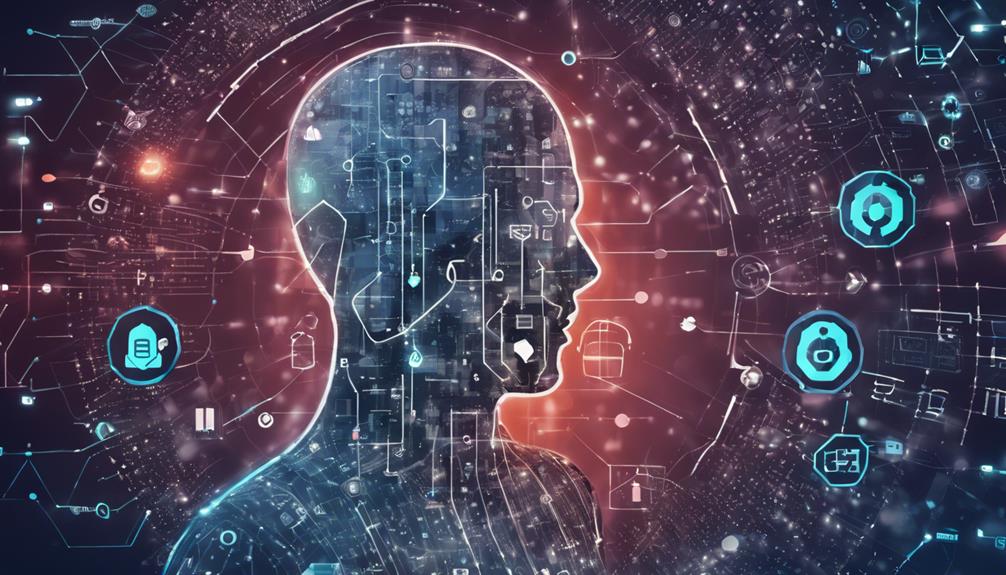Embracing AI in cybersecurity entails safeguarding data privacy, tackling false positives, fostering trust, and staying vigilant against evolving threats. With a focus on transparent AI algorithms, continuous training, and compliance, organizations can enhance their security posture. By improving explainability, innovating, and fostering human-AI collaboration, the hurdles can be overcome. The path to overcoming challenges in AI cybersecurity is paved with proactive strategies, ethical considerations, and a commitment to staying updated in a dynamic landscape.
Key Takeaways
- Implementing encryption and access controls for data protection.
- Developing advanced AI algorithms to reduce false positives.
- Ensuring AI transparency and explainability for trust.
- Continuous training for cybersecurity professionals.
- Real-time threat intelligence for adaptive defense strategies.
Data Privacy and Utilization
Ensuring data privacy while effectively utilizing information for threat detection poses a significant challenge for artificial intelligence (AI) systems in the field of cybersecurity. Privacy concerns arise from the critical need to protect sensitive information from unauthorized access or misuse.
Striking a delicate balance between data utilization for threat detection and preserving individual privacy is paramount in AI cybersecurity. Compliance with data protection regulations such as GDPR and HIPAA is essential to guarantee that AI algorithms respect user privacy rights.
To address these challenges, encryption techniques and access controls are implemented to safeguard data privacy while enabling AI systems to analyze and detect threats effectively. Responsible data utilization practices, including anonymization and data minimization, play a vital role in mitigating privacy risks associated with AI applications in cybersecurity.
Addressing False Positives

Mitigating false positives in cybersecurity is imperative for enhancing operational efficiency and minimizing unnecessary disruptions. False positives occur when a system wrongly flags normal behavior as malicious, leading to wasted resources and alert fatigue.
To address this challenge effectively, advanced AI algorithms are being developed to enhance the accuracy and precision of threat detection. Implementing contextual analysis and correlation techniques aids in distinguishing actual threats from false alarms, thereby improving the overall security posture.
Additionally, effective tuning of AI models and adjusting detection thresholds play a crucial role in reducing the occurrence of false positives in cybersecurity alerts.
Building Trust in AI Systems

Building trust in AI systems is a key aspect of ensuring their reliability and acceptance. Transparency in decision-making processes, ethical considerations in AI design, and the implementation of explainable AI methods are essential for fostering trust among users.
AI Transparency for Trust
How can AI systems achieve transparency to foster trust among users and stakeholders?
Transparency in AI systems is essential for building trust and ensuring accountability in decision-making processes.
Here are three key ways to enhance AI transparency and promote trust:
- Explainability: Providing clear explanations of how AI algorithms reach decisions helps users understand the reasoning behind outcomes, increasing trust in the system's reliability.
- Documentation: Maintaining detailed documentation of data sources, model architectures, and training processes allows for external validation and scrutiny, enhancing transparency and accountability.
- User-Friendly Interfaces: Designing user interfaces that display decision-making steps in a transparent manner can help users interact with AI systems more confidently, fostering trust in the technology.
Ethical AI Decision-making
To establish trust in AI systems for cybersecurity applications, emphasis must be placed on ethical decision-making processes that prioritize fairness, transparency, and accountability. Essential principles play a crucial role in ensuring that AI algorithms are designed and implemented in a responsible manner.
Addressing ethical implications involves actively working to prevent biases, discrimination, and unintended consequences within AI systems. Responsible AI development practices require clear guidelines to guide the design and deployment of algorithms, thereby reducing the risk of ethical violations.
By upholding ethical standards, organizations can build credibility and trust in their cybersecurity operations. Ethical considerations not only foster user confidence but also encourage acceptance of AI technologies in the cybersecurity domain.
Integrating ethical decision-making into the development and deployment of AI systems is crucial for promoting trust and reliability in the cybersecurity landscape.
Explainable AI for Assurance
Explainable AI in cybersecurity plays a pivotal role in enhancing trust by offering transparency into the decision-making processes of AI systems. This transparency enables stakeholders to grasp the rationale behind the outcomes and actions produced by AI.
Techniques used in explainable AI include decision trees, rule-based systems, and model visualization tools, aiding in the comprehension of complex AI algorithms. Building trust in AI systems through explainability is not only essential for regulatory compliance but also for effective risk management practices.
By fostering collaboration between human analysts and AI systems, explainable AI assures more efficient cybersecurity operations. Embracing artificial intelligence with a focus on transparency and trustworthiness is key in the ever-evolving landscape of cybersecurity.
As organizations navigate the complexities of AI integration, prioritizing explainable AI can lead to improved decision-making processes and heightened confidence in the security measures implemented.
Staying Updated Against Threats

In the domain of AI cybersecurity, staying updated against evolving threats is paramount. Real-time threat intelligence enables systems to swiftly identify and respond to emerging dangers.
Real-Time Threat Intelligence
Continuous monitoring of cyber threats is essential for organizations to stay updated against evolving tactics and techniques, requiring the utilization of real-time threat intelligence. AI algorithms play a vital role in this process by analyzing vast amounts of data to detect and respond to potential threats in real time.
Leveraging proactive threat intelligence, organizations can anticipate and prevent cyber attacks before they occur, enhancing their overall cybersecurity posture. Additionally, threat intelligence platforms that incorporate AI can efficiently identify patterns, trends, and anomalies indicative of malicious activities, enabling quick and informed decision-making by cybersecurity teams.
Adaptive Defense Strategies
AI technologies in cybersecurity not only enable real-time threat intelligence but also drive the implementation of adaptive defense strategies to combat evolving cyber threats effectively. These strategies involve continuously updating security measures to stay ahead of emerging threats by leveraging AI's capabilities in analyzing and responding to risks in real-time.
By monitoring network behavior and anomalies, adaptive defense strategies can proactively detect and mitigate potential attacks, enhancing the overall cybersecurity posture of organizations. The key feature of adaptive defense lies in its ability to adjust security protocols based on the ever-evolving threat landscape, ensuring a dynamic and robust defense mechanism against sophisticated cyber threats.
Organizations that embrace adaptive defense strategies can better protect their digital assets and sensitive information, staying one step ahead of malicious actors in the complex cybersecurity landscape. Embracing AI-powered adaptive defense is essential in the face of rapidly changing cybersecurity challenges to safeguard valuable data and maintain operational continuity.
Continuous Training Initiatives
Staying ahead of evolving cyber threats necessitates ongoing training initiatives for cybersecurity professionals to remain updated and adept in their defense strategies. Continuous education is key to equipping teams with the necessary skills and knowledge to tackle modern cybersecurity challenges effectively.
Here are three essential aspects to contemplate when implementing continuous training programs:
- Regular Training Programs: Conducting frequent training sessions allows professionals to stay informed about the latest attack techniques and defense strategies, ensuring they are well-prepared to handle evolving threats.
- Training on Emerging Technologies: Offering education on cutting-edge technologies like AI in cybersecurity enables teams to leverage advanced tools for threat detection and response, enhancing overall security posture.
- Ongoing Education: Continuous learning is crucial to help cybersecurity professionals adapt to new challenges, maintain expertise, and refine critical skills such as threat analysis, incident response, and the integration of AI-powered security measures. By prioritizing ongoing education, organizations can better equip their teams to defend against sophisticated cyber threats effectively.
Compliance With Data Regulations

Guaranteeing compliance with data regulations, such as GDPR and CCPA, is a critical aspect of leveraging AI in cybersecurity to safeguard sensitive information. Failure to adhere can result in substantial fines and reputational damage for organizations. These regulations mandate secure storage, processing, and transfer of data, presenting challenges for AI systems managing sensitive information.
Abiding by data regulations not only mitigates risks but also promotes transparency, accountability, and ethical data usage in AI applications for cybersecurity. It is essential for organizations to navigate the complexities of these regulations to ensure that their AI operations align with legal requirements and ethical standards.
Improving Explainability in Algorithms

Improving the interpretability of algorithms is essential in the field of cybersecurity to cultivate trust and accountability in decision-making processes. Enhancing explainability in AI algorithms can help cybersecurity professionals understand how decisions are made, leading to increased trust in the system's operations.
To improve explainability in algorithms, consider the following:
- Feature Importance Analysis: Conducting feature importance analysis allows for the identification of key factors influencing AI decisions, aiding in understanding the algorithm's reasoning.
- Model Visualization: Visualizing the AI model can provide a clear representation of how data is processed and decisions are reached, increasing transparency in the algorithm's operations.
- Explainable AI (XAI) Methods: Leveraging XAI methods can make AI decision-making processes more transparent and understandable, promoting trust and accountability within cybersecurity practices.
Innovations in AI Technology

In the domain of enhancing cybersecurity practices, the forefront of advancements lies in the continuous evolution and implementation of innovative AI technologies.
One significant area of progress is the development of advanced machine learning models tailored for improved accuracy in various cybersecurity tasks. These models enable real-time threat detection through enhanced algorithms, boosting the overall security posture of organizations.
Moreover, the automation of cybersecurity processes through the integration of AI is a pivotal innovation. This integration streamlines operations, allowing for quicker responses to potential threats and vulnerabilities.
AI technology is also evolving to seamlessly integrate with Internet of Things (IoT) security solutions, providing thorough protection across interconnected devices and networks.
Another critical focus area for AI in cybersecurity is the impact of quantum computing on encryption methods. Researchers are exploring how AI can adapt to and enhance encryption techniques to safeguard data remains secure in the face of evolving computational capabilities.
These innovations collectively drive the industry towards more robust, adaptive, and proactive cybersecurity measures.
Weaponization of AI

The proliferation of AI-powered cyber threats signifies a menacing trend in the field of cybersecurity, as adversaries increasingly exploit advanced machine learning capabilities for malicious purposes. Cybercriminals are leveraging AI-powered systems to launch sophisticated attacks, automating tasks like reconnaissance, target profiling, and malware customization to enhance the efficiency of their operations.
Adversarial attacks using machine learning techniques allow threat actors to manipulate AI systems, leading to false positives or evading detection by security solutions. The weaponization of AI poses a significant challenge in cybersecurity, as these AI-driven attacks can exploit vulnerabilities in AI models, compromising the integrity of data, systems, and networks.
- Adversarial attacks in AI: Threat actors manipulate machine learning algorithms to deceive security systems.
- Automation of cyber threats: AI-powered tools enable attackers to streamline their malicious activities, increasing the scale and impact of attacks.
- Vulnerabilities in AI models: Exploiting weaknesses in AI systems can lead to significant breaches and data compromises.
Human-AI Collaboration

Collaboration between human experts and AI technologies in cybersecurity enhances the efficiency and effectiveness of threat detection and response efforts.
In the domain of cybersecurity, human-AI collaboration plays a pivotal role in fortifying defenses against evolving cyber threats. By integrating human intuition with AI's analytical capabilities, organizations can bolster their security posture greatly.
AI algorithms streamline the process of sifting through vast troves of data, enabling human analysts to pinpoint potential security vulnerabilities swiftly.
However, human oversight remains paramount in deciphering the insights generated by AI systems and translating them into actionable responses during cyber incidents.
This harmonious partnership between human expertise and AI automation not only expedites threat detection but also facilitates a more robust incident response mechanism.
Ultimately, the fusion of human insight and AI efficiency leads to a more resilient cybersecurity infrastructure, better equipped to fend off sophisticated cyber attacks.
Frequently Asked Questions
What Is the Main Challenge of Using AI in Cybersecurity?
The main challenge of using AI in cybersecurity lies in the necessity for high-quality and extensive data to guarantee accurate threat detection and prevention, with factors like data quality issues and adversarial attacks posing significant hurdles.
How Is AI in Cybersecurity Being Improved?
AI in cybersecurity is being improved through the development of advanced machine learning algorithms, enhanced data processing capabilities, integration with other technologies like IoT and cloud computing, continuous research, and collaboration between cybersecurity experts and AI developers.
How Can We Overcome the Challenges of Artificial Intelligence?
To overcome the challenges of artificial intelligence, organizations must focus on continuous innovation, strategic planning, interdisciplinary collaboration, and proactive risk management. By fostering a culture of adaptability and embracing emerging technologies, businesses can navigate the complexities of AI integration successfully.
What Are the Threats of AI in Cybersecurity?
Threats of AI in cybersecurity include potential exploitation by cybercriminals, inaccuracies in threat detection due to false positives or negatives, vulnerability to adversarial attacks manipulating algorithms, privacy risks from accessing sensitive data, and ethical concerns regarding automated decision-making transparency.
Conclusion
In the domain of cybersecurity, the challenges posed by AI may seem intimidating, but with determination and strategic planning, these hurdles can be overcome.
By focusing on data privacy, reducing false positives, building trust in AI systems, and staying updated on threats, we can navigate the complexities of AI technology.
Through collaboration between humans and AI, we can harness the power of innovation to protect against the weaponization of AI.
Together, we can triumph over adversity and secure a safer digital future.









